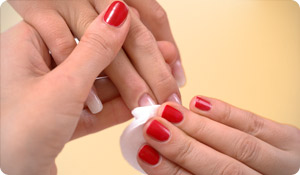
In order to do its job, nail polish remover must contain some chemicals. But did you know that many of these products contain harmful toxins? Here are some common ingredients found in nail polish remover, their potential side effects, and how to make sure you choose-and use them-safely.
Acetone is the main ingredient in most nail polish removers. This organic solvent has not been proven to be hazardous to your health in limited quantities, but there is speculation that it poses a cancer threat. The smell can also be unpleasant to breathe, cause lightheadedness and make your eyes burn. Additionally, acetone has been known to weaken your nails and make them brittle. All these have led to a wave of non-acetone nail polish removers.
Toluene (a.k.a methylbenzene or phenylmethane) is derived from petroleum or coal and has been linked to headaches, nausea, and even birth defects through repeated exposure. However, the FDA has reviewed toluene repeatedly and determined that it is safe as long as it makes up no more than 50% of the product.
Ethyl Acetate is derived from ethanol and often found in non-acetone-based nail polish removers. It's also a potential irritant and has been linked to neurological problems and cancer with prolonged exposure.
Methanol is also often found in non-acetone products and is actually more toxic at lower levels than acetone. It can irritate your skin, eyes, and lungs as well as cause dizziness and headaches.
Botanical Ingredients like Vitamin E and aloe vera are often added to improve the scent and boost moisture. While these can be beneficial for your nails, they shouldn't be the main criteria for choosing a nail polish remover.
The FDA requires nail products to be non-hazardous when used as directed. While several types do contain hazardous ingredients, if you use them as directed you should be okay. However, people who work in nail salons are at increased risk due to repeated and prolonged exposure. And as you know, products regarded as safe are often later discovered to be hazardous. Since almost all ingredients in nail polish removers are potentially hazardous, your best bet is to choose a water-based, rather than methanol- or acetone-based remover.
Be sure to follow manufacturer's instructions and the following safety tips when using nail polish remover:
- Limit use to twice a month (better for your nails and overall health)
- Always store it in a tightly capped bottle and keep it closed as much as possible during use.
- Be sure to wash your hands with soap after applying, especially if you bite your nails.
- Keep it far away from any flame or heat source, like a lit cigarette or curling iron.
- Store it out of reach from children. Ingesting any kind of nail polish remover can be fatal.
Sources:
FDA
http://www.fda.gov/Cosmetics/ProductandIngredientSafety/ProductInformation/ucm127068.htm#reg
Environmental Working Group & Skin Deep Cosmetic Safety Database
http://www.cosmeticsdatabase.com/ingredient.php?ingred06=702293
http://www.ewg.org/node/18932
National Library of Medicine Tox Town
http://toxtown.nlm.nih.gov/text_version/chemicals.php?id=1
http://toxtown.nlm.nih.gov/text_version/chemicals.php?id=30





